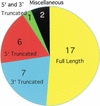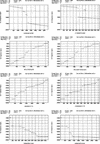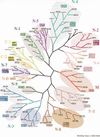Kinesin superfamily proteins (KIFs) in the mouse transcriptome
- PMID: 12819144
- PMCID: PMC403687
- DOI: 10.1101/gr.984503
Kinesin superfamily proteins (KIFs) in the mouse transcriptome
Abstract
In the post genomic era where virtually all the genes and the proteins are known, an important task is to provide a comprehensive analysis of the expression of important classes of genes, such as those that are required for intracellular transport. We report the comprehensive analysis of the Kinesin Superfamily, which is the first and only large protein family whose constituents have been completely identified and confirmed in silico and at the cDNA, mRNA level. In FANTOM2, we have found 90 clones from 33 Kinesin Superfamily Protein (KIF) gene loci. The clones were analyzed in reference to sequence state, library of origin, detection methods, and alternative splicing. More than half of the representative transcriptional units (TU) were full length. The FANTOM2 library also contains novel splice variants previously unreported. We have compared and evaluated various protein classification tools and protein search methods using this data set. This report provides a foundation for future research of the intracellular transport along microtubules and proves the significance of intracellular transport protein transcripts as part of the transcriptome.
Figures





References
-
- Ha, M.J., Yoon, J., Moon, E., Lee, Y.M., Kim, H.J., and Kim, W. 2000. Assignment of the kinesin family member 4 genes (KIF4A and KIF4B) to human chromosome bands Xq13.1 and 5q33.1 by in situ hybridization. Cytogenet. Cell Genet. 88: 41-42. - PubMed
-
- Hattori, M., Fujiyama, A., Taylor, T.D., Watanabe, H., Yada, T., Park, H.S., Toyoda, A., Ishii, K., Totoki, Y., Choi, D.K., et al. 2000. The DNA sequence of human chromosome 21. Nature 405: 283-284. - PubMed
Publication types
MeSH terms
Substances
LinkOut - more resources
Full Text Sources
Molecular Biology Databases
